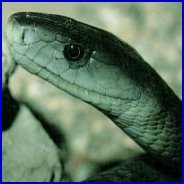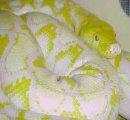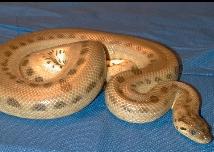Anaconda Bushmaster Cobra Mamba Vine Snake Asp Python Inland Taipan Sea Kraits
The Anaconda is a member of the Boa family and is among the largest and most powerful in the world. The Anaconda is the heaviest snake in the world. A full grown adult can reach a length in excess of 20 feet and weigh over 200 pounds. Anacondas can be found near river systems in the Amazon. For this reason, the Anaconda is also known as the Water Snake. Their nostrils are located on the top of their head, which allows them to breathe while they are swimming. The Anaconda is nocturnal. The Yellow Anaconda can be found near river systems in South America.
Yellow Anaconda

Bushmaster
The Bushmaster is the largest pit viper in North and South America. While it does not have a rattle, it vibrates its tail when agitated. It is related to the rattlesnake. It can be found in South America in tropical areas. The average length of a Bushmaster is 8 feet. It is the only pit viper to lay eggs.

King Cobra
The King Cobra is the longest venomous snake in the world with an average length of 12 feet. It can be found in the Philippines, Malaysia, Southern China, Myanmar, India, Thailand and the Malay Peninsula. It primarily eats other snakes. The Black Cobra can spit its venom as far as 8 feet into the eyes of its intended prey causing temporary blindness and extreme pain. The hood of the Common Cobra is larger than that of a King Cobra even though the Common Cobra is smaller in overall size.

Green Mamba

Black Mamba
The Green Mamba is a smaller relative to the Black Mamba, but is just as deadly. The Green Mamba is green in colour while the Black Mamba is actually a dark grey to olive brown. The name "Black Mamba" actually refers to the lining inside its mouth - which is black. The Black Mamba grows to about 14 feet in length and is the most feared snake in South Africa. The venom is neurotoxic and cardiotoxic. The venom from one bite is more than enough to kill several humans. The venom can be lethal in as little as 30 minutes. They have been known to take shelter in populated areas and are very territorial. This makes it hard to remove them and relocate them back in the wild. The Mambas are arboreal (tree dwellers).
The Vine Snake is a very thin snake with colouring that matches the bark of trees. Its head is shaped like a javelin and it has large eyes. This snake is also arboreal and uses the cover of trees to ambush prey. It strikes down at its intended prey from the branches of trees. Its diet consists of small lizards, frogs and birds. It also hunts other small snakes. Its venom is haemotoxic, which prevents the blood from clotting. Its victims can literally bleed to death. It is a day hunter and eats while hanging upside down.

Vine Snake
There are two species of Asp.
The Asp is a member of the cobra family. It is also called the Egyptian Cobra and is found throughout northern Africa. The Asp was worshipped in ancient Egypt and was used as the symbol on the crown of the pharaohs. It is believed that Cleopatra killed herself with this snake which would have guaranteed her immortality.
There is another snake known as an Asp. The European Asp is a viper. This snake ranges throughout the Mediterranean region of Europe, but can be found as far north as Sweden. The European Asp is moderately sized and is characterized by a broadly triangular head and a vertically shaped pupil. When threatened, the European Asp will hiss and rapidly jerk its head forward in a striking motion. The venom of this snake is a haemotoxin.

European Asp
This family includes the Burmese, the Indian, African Rock, the Ball and the Reticulated (Royal) Python. The Reticulated Python of Southeast Asia is considered the largest snake in the world reaching lengths of 33 feet. Pythons can be found in the tropical and subtropical regions of Africa, Asia, Australia and the Pacific Islands. Pythons are expert climbers and swimmers. Their main food sources are mammals (including porcupines!), pigs and goats. About 20 species of pythons exist in the world today. The females lay anywhere 15 to 100 eggs.

The Big Squeeze - An albino Reticulated Python
Taipan venom is overwhelmingly neurotoxic having a severe affect on the nervous system. The Inland Taipan is easily the most toxic land snake in the world. A lethal dose is estimated to be 50 times that of the Indian Cobra. Despite being the most toxic snake in the world, the Inland Taipan is quite shy and has a placid disposition. The Inland Taipan shelters in rat burrows (probably after eating the former inhabitant), in deep soil cracks and sinkholes. It feeds on small to medium sized mammals such as rodents. It will either make a single bite or multiple quick strikes. The Inland Taipan can swing its body in midair to strike a handler with a grip on its tail.

Inland Taipan
The Sea Krait is a marine snake. Their nostrils have closure flaps to keep water out when they are submerged. They also have a flattened tail that aids in paddling. The Sea Krait even bear their young in the water. They are about 4 feet long and can be found in oceans surrounding China, Taiwan, Japan, Philippines and Indonesia. The Yellow-lipped Sea Krait can be found in the oceans surrounding Japan and Australia. They feed on eels and fish.
Don't kiss me - fool. Yellow-lipped Sea Krait and the Sea Krait

